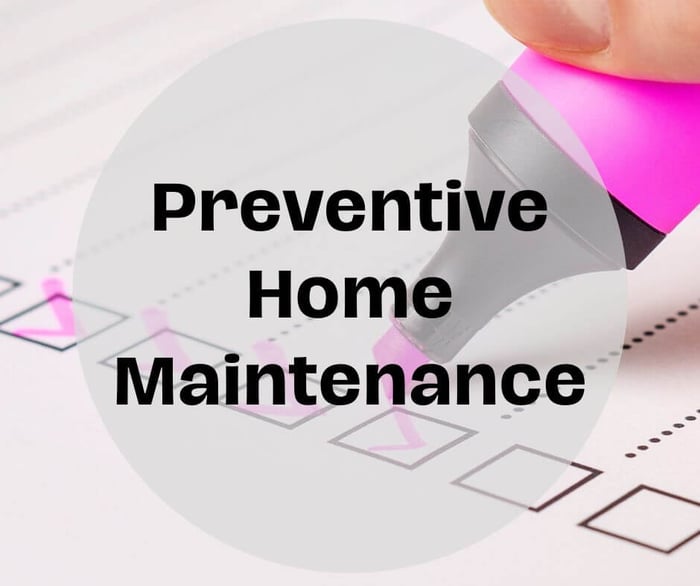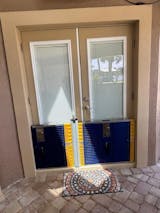Preventive home maintenance is something you do to make sure that your house is safe and comfortable for you and your family today, and that it won`t lose its value in the future.
Regular upkeep can help you find and address issues before they become major problems.
Here's a comprehensive list of preventive home maintenance tasks you should consider:
- Inspect the Roof:
- Check for damaged or missing shingles.
- Clean gutters and downspouts to ensure proper drainage.
- Look for signs of leaks or water damage in the attic.
- Check for Leaks:
- Inspect plumbing for leaks, including faucets, pipes, and under sinks.
- Examine ceilings and walls for water stains.
- Heating, Ventilation, and Air Conditioning (HVAC) Systems:
- Change HVAC filters regularly.
- Schedule professional HVAC system inspections and maintenance annually.
- Clean air ducts to improve air quality.
- Inspect and Clean Appliances:
- Clean refrigerator coils.
- Check and clean the lint trap in the dryer.
- Service the water heater as recommended by the manufacturer.
- Test Smoke and Carbon Monoxide Detectors:
- Replace batteries in smoke detectors and test them monthly.
- Install and regularly test carbon monoxide detectors.
- Seal Windows and Doors:
- Check for drafts and seal gaps with weatherstripping or caulk.
- Inspect window and door frames for signs of damage or rot.
- Inspect and Clean Chimney and Fireplace:
- Schedule professional chimney sweeps annually.
- Ensure the damper is functioning properly.
- Examine the Exterior:
- Check the foundation for cracks and signs of settling.
- Inspect the siding for damage and repair or replace as needed.
- Trim trees and bushes away from the house.
- Clean and Maintain Gutters:
- Clean gutters regularly to prevent clogs.
- Ensure downspouts direct water away from the foundation.
- Pest Control:
- Regularly inspect for signs of pests and take preventive measures.
- Seal any cracks or openings where pests could enter.
- Inspect and Clean the Attic:
- Look for signs of pests or rodents.
- Ensure proper insulation and ventilation.
- Test Electrical Systems:
- Check outlets and switches for any issues.
- Schedule an electrician to inspect the wiring if needed.
- Drainage and Grading:
- Ensure that the ground around your home slopes away from the foundation to prevent water accumulation.
- Pressure Wash Exterior:
- Remove dirt, mildew, and stains from the exterior surfaces of your home.
- Check and Service Lawn Equipment:
- Sharpen lawnmower blades and perform routine maintenance on other tools.
- Inspect and Clean Drains:
- Keep sinks and drains clear to prevent clogs.
Regularly performing these preventive home maintenance tasks can help you find and address issues early, saving you time and money in the long run. Create a preventive home maintenance schedule or checklist to stay organized and ensure that these tasks are completed on a regular basis.

Anti-flooding preventive home maintenance
Preventing home maintenance is very specific when you live in a flood-prone area.
Here are some preventive home maintenance tips to help minimize the risk of flooding:
- Install a Sump Pump:
- Consider installing a sump pump in the basement to pump out excess water in case of flooding.
- Regularly test the pump to ensure it is working properly.
- Seal Foundation Cracks:
- Inspect your foundation for cracks and seal them to prevent water seepage.
- Apply waterproofing coatings to basement walls.
- Check and Clean Gutters and Downspouts:
- Keep gutters and downspouts clear of debris to ensure proper water drainage.
- Extend downspouts away from the foundation to direct water away.
- Install French Drains:
- French drains can help divert water away from your home's foundation. Consider installing them in areas prone to flooding.
- Elevate Electrical Systems:
- Elevate electrical outlets, switches, and wiring at least one foot above the expected flood level.
- Install Backflow Preventers:
- Install backflow preventers on sewer lines to prevent sewage backup during heavy rains.
- Raise Appliances and Mechanicals:
- Elevate water heaters, furnaces, and other critical appliances above potential flood levels.
- Use Flood Barriers
- Consider getting flood barriers to easily create dams around your house or any outdoor construction. They are easy to use and extremely efficient against floodwaters.
$949.00
DAM EASY® FLOOD GATE - DOOR DAM Floods are becoming more common around the world. What was once a 100-year phenomenon is now a seasonal trend that homeowners must deal with. That’s EXACTLY why you need this Dam Easy Flood… Read MoreFlood Barrier Door Dam - Ultimate Flood Gate

- Landscape Grading:
- Ensure that the ground around your home slopes away from the foundation to prevent water from pooling.
- Install Window Well Covers:
- Install covers on basement window wells to prevent water from entering through windows.
- Maintain a Clear Stormwater Drainage System:
- Ensure that stormwater drains on your property are clear of debris and functioning properly.
- Inspect and Maintain Stormwater Management Systems:
- If your property has stormwater management features (e.g., retention ponds), ensure they are well-maintained and functioning.
- Elevate HVAC Equipment:
- If possible, elevate outdoor HVAC units to protect them from flood damage.
- Invest in Flood Insurance:
- Consider purchasing flood insurance to provide financial protection in case of flooding.
- Regularly Inspect and Maintain Your Roof:
- Ensure that your roof is in good condition to prevent leaks that could contribute to flooding.
- Know Your Property's Flood Risk:
- Understand your property's flood risk and take appropriate measures based on local conditions.
- Create an Emergency Plan:
- Develop an emergency plan that includes evacuation routes and contacts in case of flooding.
Remember that preventive measures may vary based on your specific location, topography, and local regulations. Consult with professionals if you need assistance with more complex preventive measures or if you live in an area prone to severe flooding. Regular inspections and maintenance are key to minimizing flood-related risks to your home.
How much does preventive home maintenance cost?
So, how much will you have to spend every year in order to make sure that the next flooding won`t catch you off-guard or that a pest problem won`t show itself when it is too late already?
Here are the approximate prices, which create an overall budget for a homeowne
r. However, keep in mind, that the actual process will depend on many factors such as the brands that you choose and retailers as well as whether you decide to do the chores yourself or address professionals.
Anyway, prevention is always cheaper and easier than treatment.
- Basic Hand Tools:
- Screwdrivers, pliers, wrenches, and a hammer.
- Approximate Cost: $20 - $50 for a basic set.
- Measuring Tools:
- Tape measure and a level.
- Approximate Cost: $10 - $20.
- Safety Gear:
- Safety glasses, work gloves, and a dust mask.
- Approximate Cost: $15 - $30.
- Ladder:
- For tasks like cleaning gutters or inspecting the roof.
- Approximate Cost: $50 - $150 depending on size and type.
- Caulk Gun and Caulk:
- For sealing gaps and cracks in windows, doors, and other areas.
- Approximate Cost: $10 - $20 for a caulk gun, $3 - $10 per tube of caulk.
- Weatherstripping:
- To seal gaps around windows and doors.
- Approximate Cost: $5 - $20 per pack.
- Air Filters:
- For HVAC system maintenance.
- Approximate Cost: $5 - $20 per filter.
- Gutter Cleaning Tools:
- Gutter scoop or trowel for removing debris.
- Approximate Cost: $5 - $20.
- Flashlight:
- For inspecting dark or hard-to-reach areas.
- Approximate Cost: $10 - $30.
- Pipe Wrench or Adjustable Wrench:
- For tightening or loosening plumbing connections.
- Approximate Cost: $10 - $30.
- Plunger:
- For clearing minor clogs in drains.
- Approximate Cost: $5 - $15.
- Duct Tape:
- Versatile for temporary fixes and sealing.
- Approximate Cost: $3 - $10 per roll.
- Garden Hose and Nozzle:
- For cleaning exterior surfaces.
- Approximate Cost: $20 - $50.
- Extension Cord:
- Useful for reaching outdoor areas for maintenance.
- Approximate Cost: $10 - $20.
- Cleaning Supplies:
- All-purpose cleaner, rags, and a scrub brush for various cleaning tasks.
- Approximate Cost: Varies based on brands and quantity.
- Smoke Detector Batteries:
- For replacing batteries in smoke detectors.
- Approximate Cost: $5 - $10 per pack.
This rough estimate totals around $200 to $600 for basic tools and materials.
Want to know more about flood safety and the latest flood control solutions? Contact Dam Easy today! Our teams will help you estimate the flood risks of your property and choose the best flood barriers and other anti-flooding solutions that will let you stay safe and sound no matter what Mother Nature will bring tomorrow.
Don`t worry. We will make it Dam Easy for you!



















